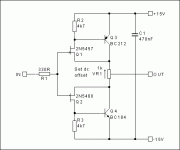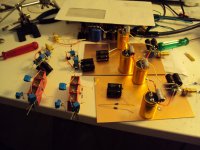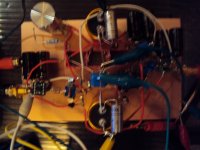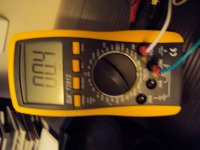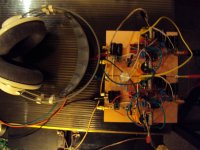I see no reason why those Fets should not work here.
A simple parallel symmetric buffer whithout the BJTs whould work well too.
John Curl made buffers that way.
I will try my RME Firface 400 card today and try to make some higher resolution distortion measurements.
The RME card should be better then my M-Audio Transit.
A simple parallel symmetric buffer whithout the BJTs whould work well too.
John Curl made buffers that way.
I will try my RME Firface 400 card today and try to make some higher resolution distortion measurements.
The RME card should be better then my M-Audio Transit.
I guess we all need a small dead bug construction headphones amp to fit in our phono stages as standard. So we can listen to vinyl at night without feeding through preamps, interconnects, stand alone headphones amps. It can be a an integrated phono-phones-preamp even if we steal for current boosted RCA output too. What do you think?
i knew the JLH buffer for many years but i never tried it until recently. That was a mistake, it works very well indeed.
Can the trimmer really null the offset at JLH's output node in your experience from when you implemented it as input stage in your headphones amp? Or it will need cap coupling if a standalone volume buffer for instance?
The offset can be nulled and is very stable at + - 0.1mV.
PSU needs stable voltage of cause so after i listened 2 hours on 7AH batteries the offset was 0.3mV on one channel and 0.4mV on the other becaue the batteries did not have equal voltage any more. No problem with the sound though.
PSU needs stable voltage of cause so after i listened 2 hours on 7AH batteries the offset was 0.3mV on one channel and 0.4mV on the other becaue the batteries did not have equal voltage any more. No problem with the sound though.
Now I think if we put BD139,140 directly in the JLH Jfet-BJT compound follower, maybe we can directly drive headphones with just 4 semiconductors and a healthy voltage input for it?
That should be posible.
The circuit as is can drive 150 Ohm, so even that circuit could already drive high impedance phones.
The circuit as is can drive 150 Ohm, so even that circuit could already drive high impedance phones.
Good turntables are not expensive any more.
For example Clearaudio and Rega make good packages of turntable, arm and cart. for
1000,- - 2000,-€. Later a better cart. can be added.
There is also a lot of good stuff on the used market.
Errata : Ikoflexer found a small mistake in circuit post 1088.
The LME49713 op amps PSU connection is reversed. Pin 4 should go to - supply and pin 7
should go to + supply of cause.
A Rega P3 + arm went on eBay yesterday for 277 euro....
jd
A Rega P3 + arm went on eBay yesterday for 277 euro....
jd
Look for any Systemdek or Audionote in very good condition too.
I found a JLH buffer with higher current output, usable as headphone buffer.
It is called a Jisbos and was posted by Juma. Good soundquality is reported.
i have and idea of an even simper 4 transistor buffer with gain, based on folded cascode priciples like in the MPP. I will post that later.
Today i am building the darlington version of the JLH buffer.
It is called a Jisbos and was posted by Juma. Good soundquality is reported.
i have and idea of an even simper 4 transistor buffer with gain, based on folded cascode priciples like in the MPP. I will post that later.
Today i am building the darlington version of the JLH buffer.
Attachments
I build the JLH Darlington Buffer and it works very well.
It is much faster then the verion with BC550 / 560.
It goes up to 14MHz - 3dB, the first version only went to 1.4MHz.
It has a slight overshot in the 9Mhz region so i will try to raise the gate stopper.
It is much faster then the verion with BC550 / 560.
It goes up to 14MHz - 3dB, the first version only went to 1.4MHz.
It has a slight overshot in the 9Mhz region so i will try to raise the gate stopper.
Now I think if we put BD139,140 directly in the JLH Jfet-BJT compound follower, maybe we can directly drive headphones with just 4 semiconductors and a healthy voltage input for it?
That should be posible.
The circuit as is can drive 150 Ohm, so even that circuit could already drive high impedance phones.
I found a JLH buffer with higher current output, usable as headphone buffer.
It is called a Jisbos and was posted by Juma. Good soundquality is reported.
i have and idea of an even simper 4 transistor buffer with gain, based on folded cascode priciples like in the MPP. I will post that later.
Today i am building the darlington version of the JLH buffer.
Aha, that was tried after all. Cool. Now if you will add some gain successfully too, we talk a very diy friendly solution. Good luck.
PCBs may be nice and tidy, but there's a charm that these "air sculptures" have and I like them a lot. Nothing else says "research" more than these. 🙂
One channel of the JG Self is up and running.
No hum and very low noise. This new AD chip is superbly quiet.
I listened to headphones ( Sennheiser HD280 Pro) and drive is ample and clean.
Offset can be adjusted with the trimmer in the buffer so a servo is not neccesarry
Ofset before the subsonic filter is around 200mV and 1mV after it, so this is no problem.
Offset is a bit dependent on the setting of the volume control. It is 0.4mV full down and -0.5mV full up. I think that is no big deal.
No hum and very low noise. This new AD chip is superbly quiet.
I listened to headphones ( Sennheiser HD280 Pro) and drive is ample and clean.
Offset can be adjusted with the trimmer in the buffer so a servo is not neccesarry
Ofset before the subsonic filter is around 200mV and 1mV after it, so this is no problem.
Offset is a bit dependent on the setting of the volume control. It is 0.4mV full down and -0.5mV full up. I think that is no big deal.
Attachments
Self ready
The JG Self is ready in Stereo. It´s quiet like a brick and worked right away.
It even drives the AKG701 to decent volume. That LME49713 is powerfull.
Bass is tight, fast and clean. No question the result of the well designd subsonic filter.
Tomorrow i listen over loudspeakers but i know what to expect.
The sound has a kind of vintage character that is typical for a design with english genes.
Very neutral and nothing is overemphasized. Each intrument has the same proportion so to say. RIAA should be superbly accurate anyway.
i got a new poweramplifier on lone. It is a Berentzen Special Edition so i am much looking forward to the tomorrow session.
By the way, the Baxandall active volume control works superbly well. It´s a shame that it is not used more. I use a Vishay-Spectrol 148 conductive plastic and channel balance is superp without using an exotic pot. That Spectrol costs around 10,-€ at Farnell.
The JG Self is ready in Stereo. It´s quiet like a brick and worked right away.
It even drives the AKG701 to decent volume. That LME49713 is powerfull.
Bass is tight, fast and clean. No question the result of the well designd subsonic filter.
Tomorrow i listen over loudspeakers but i know what to expect.
The sound has a kind of vintage character that is typical for a design with english genes.
Very neutral and nothing is overemphasized. Each intrument has the same proportion so to say. RIAA should be superbly accurate anyway.
i got a new poweramplifier on lone. It is a Berentzen Special Edition so i am much looking forward to the tomorrow session.
By the way, the Baxandall active volume control works superbly well. It´s a shame that it is not used more. I use a Vishay-Spectrol 148 conductive plastic and channel balance is superp without using an exotic pot. That Spectrol costs around 10,-€ at Farnell.
Attachments
Aditions to homelab
I started to think about usefull adtions to my homelab that i can make myself.
First i build a measuremnt setup for Rbb. It uses the substitution method after Mc.Cormick.
i bought parts for a RIAA encoder too.
In the long run i will get a Quan-Tech noise analyser if i can find one.
I started to think about usefull adtions to my homelab that i can make myself.
First i build a measuremnt setup for Rbb. It uses the substitution method after Mc.Cormick.
i bought parts for a RIAA encoder too.
In the long run i will get a Quan-Tech noise analyser if i can find one.

